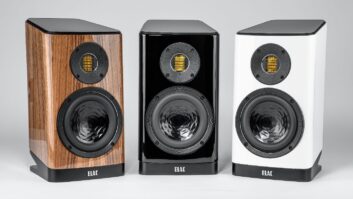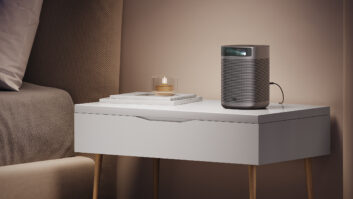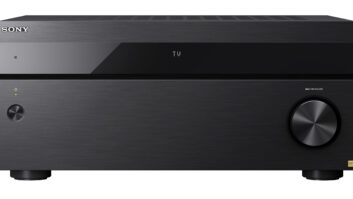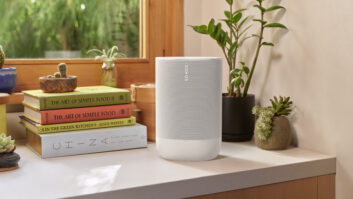by John Sciacca
My second day (third if you count media day) at International CES 2012 started with a breakfast meeting with a company that was new to me, HiFiMan. Founded by Dr. Fang Bian, this company’s goal seems to be all about bringing high-resolution audio listening to the portable world. And for people for whom “MP3” is a four-letter word, the new HM-601 Slim player will be a breath of fresh and open, high-resolution air.
The player uses a Burr Brown PCM1704u decoding chip that allows it to handle decoding high-res FLAC files (at least up to 96/24), as well as Ogg, WAV, AAC, WMV, and MP3. This player allows audiophiles to enjoy their high-res music in the highest quality while still being on the go. On top of the Slim’s superb DAC, it also features an improved headphone amp section. It will be available in 4 GB ($199) and 8 GB ($249) models and can be expanded up to 32 GB by using an SD card. It also has an adjustable gain output for use with in-ear headphones and a separate high-gain output for full-sized headphones. Sticking with the theme of no-compromise mobile listening, HiFiMan also debuted its HE-400 planar magnetic design over-ear phones. These feature 92.5 dB of sensitivity, meaning they can be driven by typical iPod/Phone devices. The phones had the wonderful, open, airy mid-range sound characteristic of planar drivers as well as deep bass extension.


Top, HiFiMan founder Dr. Fang Bian’s goal seems to be all about bringing high-resolution audio listening to the portable world. Bottom, the HM-601 Slim player HE-400 planar magnetic design over-ear phones.
A stop by IOGEAR’s booth – and a critically low iPad battery – led to a serendipitous discovery. IOGEAR allowed me to floor-test its mobile power charger for iPad ($59). This device slipped easily into my pocket and took my Pad from 20 percent to 70 percent while still being used to film videos throughout the day. In this day of constantly needing power, I can’t recommend this little lifesaver enough. It can simultaneously charge an iPad and iPhone and holds its power for several weeks. Not a bad device to chuck in your portable go kit!

IOGEAR’s mobile power charger for iPad
Following IOGEAR, I decided to brave the video giants of the Las Vegas Convention Center’s Central Hall. To understand just how large these booths are, imagine a time in the medieval ages when feudal lords built huge, fortress walls around their cities. Inside all of their inhabitants lived happy lives, completely oblivious to the goings-on outside the city walls. CES booths are kind of like that. Except way less happy, and way more crowded and way, way hotter.
Moving two feet in any direction has you encountering people in a manner that would possibly be misdemeanor assault and various other privacy violations in normal, non-war times. Also, there are virtually no landmarks to go by, and if you make the horrible mistake of leaving a booth from an exit different from that which you entered, you can often find yourself wandering around for hours looking for some way to regain your bearings. A little known fact is that thousands actually die each year, after wandering the show floor until they eventually collapse from dehydration and exhaustion. Nothing can give you an accurate scope of “the floor” like video, so I took some images from each of the biggies.
LG had an amazing number of panels linked together in some incredible video-wall fashion beckoning – or frightening – viewers into their booth. The effect was actually incredibly immersive and cool, and I’d love to take a look at the electronics and set-up involved to pull this off.
Panasonic’s booth usually has an impressive spectacle, but since they didn’t have a giant 200-inch plasma to show off this year, they instead touted their partnership with the 2012 London Olympic Games, which will be broadcast in 3D.
Toshiba was promoting its glasses-less 3D, which I had to check out. Critics say that the glasses are one of the biggest obstacles to adoption of 3D viewing, and, obviously, if you could successfully eliminate the glasses, you would likely attract more converts. These sets have a variety of “sweet spots” that viewers can be in and still experience the 3D effect. When in an optimum, 3D-approved position, a small green circle appears within another green circle at the top of the screen. I didn’t find the effect that impressive, and it really reminded me of looking at those lenticular 3D postcards. Apparently when only one viewer is watching, an eye-tracking sensor optimizes the 3D experience. I’m unconvinced.
Sharp showed its AQUOS Board at its press event. It’s a 60-inch panel designed for the business market. This allows users to easily draw and make notes on the screen, which is perfect for presentations and making your next PowerPoint presentation less soul-crushingly boring. Here’s the AQUOS Board in action.
As mentioned in my Press Day recap, Sharp was also unveiling its latest technology statement where its leapfrogged the next generation of 4K sets by going straight to 7680 x 4320, 32 million pixels of 8K resolution! This set offers 16-times the resolution of so-last-year 1080p sets and has pixels SO tiny you can smash your nose up against the 85-inch screen and still not see a single, individual dot. Also, the irony of filming an 8K set with my low-pixel iPad2 camera was not lost on the people around me. To that I say, shut up and enjoy!
Samsung always has an impressive city, and they didn’t disappoint this year. Its new 8-series line-up continues with the micro-bezel design that has been so popular with consumers and this year that they’ve added a host of new Smart TV features, including cameras for Skype video chat and motion control. The booth had TVs everywhere, including suspended from the ceiling. Also on display were the new 55-inch OLED displays that are incredibly bright, super contrasty and micro-thin. I loved the brushed metal back panel, which added to the sleekness of the design. Please to enjoy this video.
After a near heat-induced anxiety attack brought on hints of a fainting spell, I headed up to the pressroom for a quick lunch (OK, it wasn’t that quick) and then met with Control4. Control4 is introducing two new processors that offer WAY more power for system control. The benefit of the power is a much – MUCH – speedier user interface experience, especially when changing to control different rooms or browsing through a media library. The new HC800 ($999, February) has performance approximately 10 percent greater than the more expensive HC1000 and 10-times that of the HC300. It also has HDMI output, much faster Zigbee traffic processing, an external 20 dB gain Zigbee radio antenna and four audio outputs. The new HC250 ($599, Q2) is approximately 4.5-times faster than the HC300 and with its ability to be powered-over-Ethernet, only requires a single Cat-5 cable for both power and control.
Also coming in the second quarter is Control4’s new full-motion, H.264 door video intercom station. This thing is built like a tank, and comes in a several attractive metal finishes. Complementing the video intercom station are the new 7-inch portable and in-wall touchscreens with camera. Both will be available next month for $999.
Control4 is also compiling a list of preferred network vendors, with set-up and configuration files that are proven to offer the most reliable performance for both consumer and commercial systems in small, medium, and large systems. The final bit of news that really excited me was that starting with all products shipped February 1, Control4 is changing its warranty policy. Control4 will now offer immediate replacement for products within the two-year warranty period, including free next-day, overnight shipping. (They also pick up the return shipping of the defective component. You hear that other manufacturers? That’s how you handle warranty issues!) Now with remote diagnostics, a dealer could eliminate a truck roll along with several painful days of downtime for a client, ensuring that systems have maximum uptime. This is a great service and will help dealers look like heroes in their ability to quickly address and resolve any issues.

Control4’s new HC800 ($999, February) has performance approximately 10 percent greater than the more expensive HC1000 and 10-times that of the HC300.
My final stop was THX’s suite where I checked in on the latest developments of its Media Director technology. I’ve been following this for several years – back when it was code-named “Project Blackbird” – and with the passing of each year, the system gets more and more developed with additional partners and encoded content. In a nutshell, metadata is embedded into content – TV shows, films, video games – that then instructs the system for optimum settings of things like color gamut, gamma, aspect ratio, surround mode etc. In this video, THX technology development director, Geoffrey Tully, explains and demonstrates Media Director in action.







